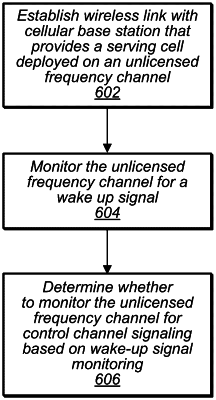| CPC H04W 52/0229 (2013.01) [H04W 72/0446 (2013.01); H04W 74/006 (2013.01); H04W 74/0816 (2013.01)] | 20 Claims |

|
1. An apparatus, comprising:
one or more processors configured to cause a wireless device to:
establish a cellular link with a cellular base station, wherein the cellular base station provides a cell that is deployed on an unlicensed frequency channel;
monitor the unlicensed frequency channel for a wake up signal, wherein the wake up signal is provided in a plurality of narrowband transmissions at different frequency locations within the unlicensed frequency channel; and
determine whether to monitor the unlicensed frequency channel for control channel signaling for at least a first slot or mini-slot of the cell that is deployed on the unlicensed frequency channel based at least in part on whether a wake up signal is detected.
|